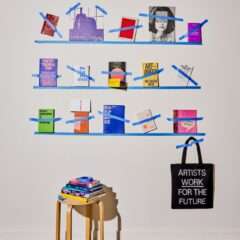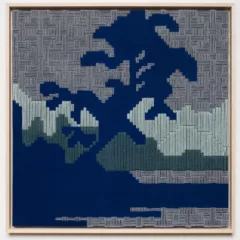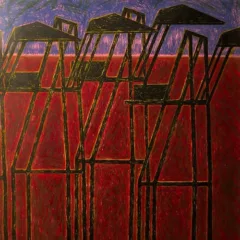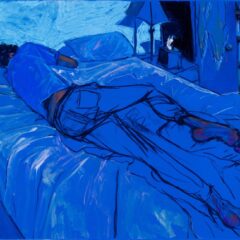Two solo shows at Pentimenti are worth wading through piles of snow for–Joseph Hu’s exhibit “Noticed and Unnoticed” and Hunter Stabler’s exhibit “Center of the Cyclone”.
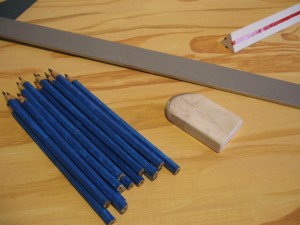
In a perfect art historical storm, Joseph Hu’s life-size sculptures, including pencils and an eraser, and Vija Celmin’s giant pencil sculpture at the Seductive Subversion exhibit at University of the Arts are on exhibit at this same moment of time.
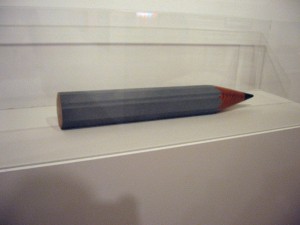
The similarities, the genealogy, and the differences, both physical and philosophical come rushing in.
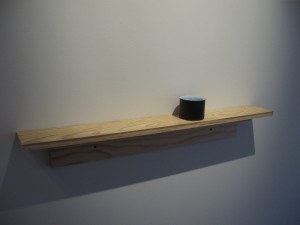
Here both artists are looking hard at the ordinary objects of daily life, paying close attention to how they look. Celmins’ ordinary pencil, like her pink pearl eraser and her comb (not on exhibit here now), would be trompe l’oeil if they were of real-life scale. But they are not. They are supersized, in a salute to American exuberance as well as a Pop commercial value. But more to the point, the large size imbues these objects with personal value and meaning. The scale turns them into stand-ins for the artist–expressions of her identity and her memories.
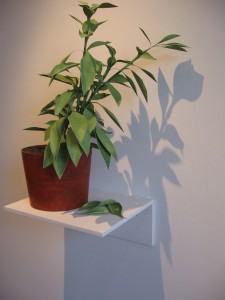
Nearly 50 years later, Hu is creating similarly ordinary objects from daily life with similarly astonishing execution. But his materials are humbler than Celmins’ wood, just as his scale is humbler. Hu is mostly working with cardboard and paper. Even the shelves on which the objects rest may look like wood but they too are cardboard–wood transformed into a flimsier state. The shelves and the objects are indeed magically trompe l’oeil, not because they are more realistic than Celmins’ pieces but because they are in a realistic scale. But the material is DIY–modest and contemporary, not made for eternity perhaps.
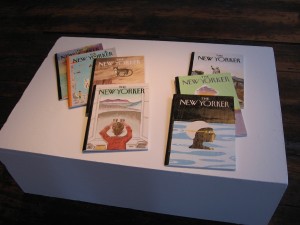
Putting the very ordinary in the trompe l’oeil tradition results in a remarkable elevation of value of objects and materials that seem disposable. Hu wins us over with the vulnerability of the pieces at the same time that he offers us a personal invitation into his private world, his home. Celmins calls up personal memories. Hu calls up today–which seems quite in line with the way the vulnerability of the materials and their revelation of the personal becomes an intimation of mortality. Today is ephemeral and so is the art and so are we. And the artist’s personal space also is in danger of collapse, as we the audience become voyeurs into Hu’s private life.
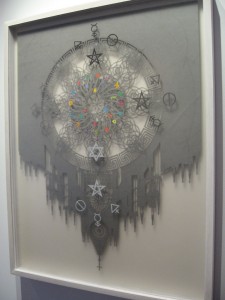
Hunter Stabler’s cut paper is also astonishing for its technical craftsmanship. He is a master paper cutter who has long been a wizard of mandala-like lacy creations that mash up the religions of the world. For all the transcendental fervor and whirling dervish snickersnack, the work is remarkably cool in its uber control and seemingly mathematical precision.
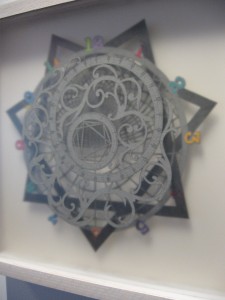
Stabler has added layers, now, that add the illusion of soft, smokiness to his sharp blade work. Yet the precision remains, as startling as ever. And the material remains as fragile as ever, just like ecstatic states. I am reminded of numerology and kabbalah, systems of (il)logic for reaching ecstatic understanding.
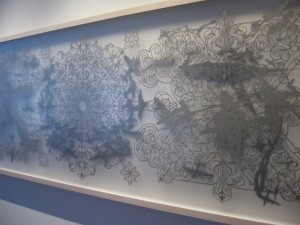
The addition of airplane imagery into the iconography of religion suggests that war too is a belief system folly.
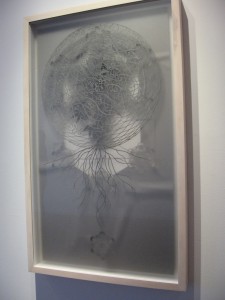
The real ecstasy of Stabler’s work is in the making–he works 8-hour days! While the work seems as if it could serve as a mandala or tankha, antithetically, the level of cool control and work suggests its antithesis–doubt and control. And the jokey titles serve as reminders that this work is post-modern ironic tongue-in-cheek. Either way, whether you want to see it as the stairway to heaven or the stairway to folly, it is a visual WOW!
Both shows at Pentimenti run to Feb. 27.


